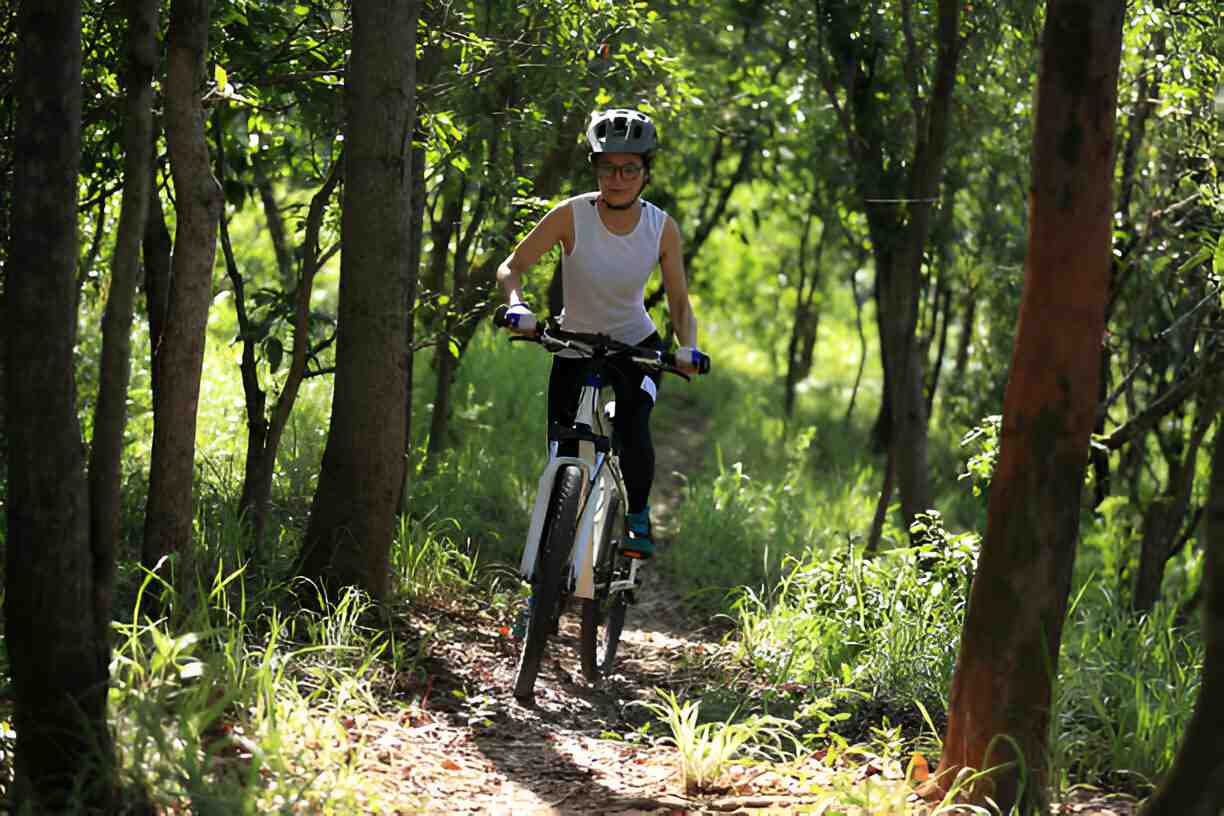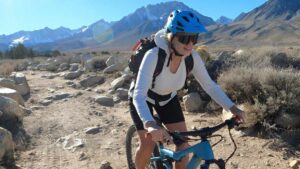Being a solo mountain biking, you do know the feels of crushing single tracks all on your own, but deep inside, it’s one thing you do understand: caution is the key. Whether one is an avid or novice rider, riding alone might be risky in its own ways. To ensure an adventurous yet safe solo ride, extra measures must be taken. We’ll cover crucial safety tips to keep you safe on the trails, from letting someone in on your itinerary to using a GPS satellite communicator. With these tips, you should be able to help ensure that your solo mountain bike adventures are tinged with freedom and excitement but essentially low in risk.
Types of Risks Associated with Solo Mountain Biking
One major aspect of solo mountain biking is the kinds of risks associated with it. As a solo rider, you are more vulnerable to accidents, injuries, and other hazards that can occur on the trail. Here are some of the types of risks associated with solo mountain biking:
- Injuries and Accidents
- Getting Lost or Stranded
- Inclement Weather Conditions
Knowing this risk is important to take precautions to adapt or reduce its impacts.
| Risk Type | Description |
|---|---|
| Injuries and Accidents | Solo riders are more prone to injuries and accidents due to lack of immediate assistance. |
| Getting Lost or Stranded | Riders can easily get lost or stranded in remote areas with no cell phone signal. |
| Inclement Weather Conditions | Solo riders are more vulnerable to harsh weather conditions, such as thunderstorms or extreme temperatures. |
| Wildlife Encounters | Riders may encounter wild animals, such as bears or snakes, which can be a significant threat. |
| Equipment Failure | Solo riders may not have the necessary tools or expertise to repair equipment failures, leaving them stranded. |
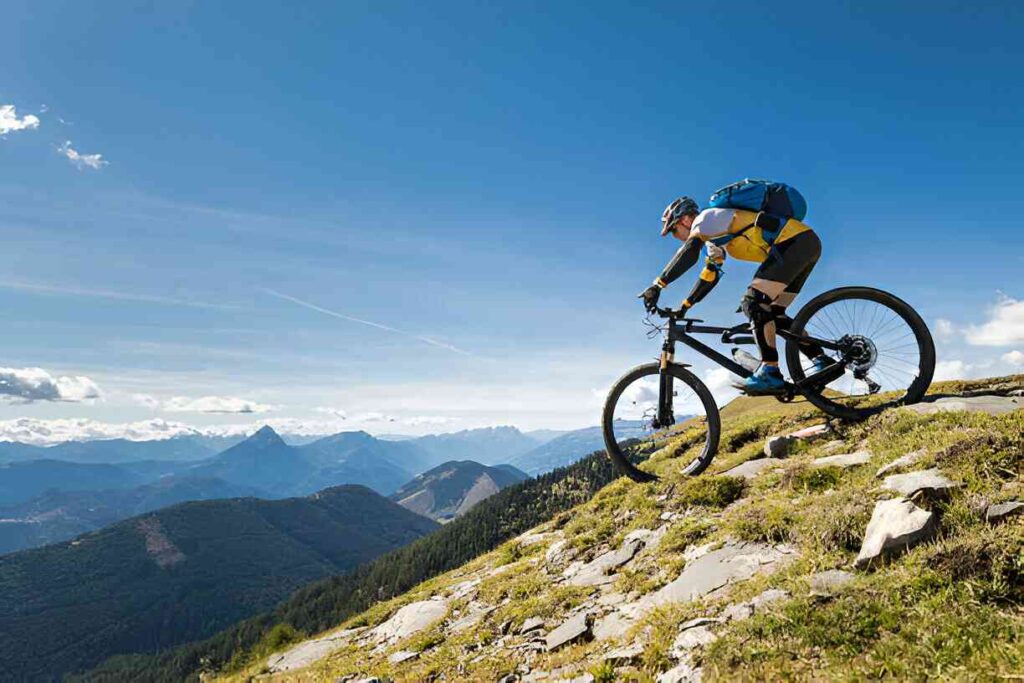
Injuries and Accidents
A solo rider is obviously more prone to injuries and accidents, as there is nobody to help him instantly. Even minor injuries can become serious if the proper treatment is not given, and he may not have the required medical kit and expertise to administer it on his own body.
Getting Lost or Stranded
Some riders may not be familiar with the trail or may not have a GPS device, and thus it is quite easy to get lost or stranded in such places that are way too far from any kind of civilization and perhaps out of reach from cellular signals.
In such areas, rescue missions could sometimes take even hours, or in really bad cases, days, before stranded riders are rescued, and this can subsequently lead to very serious health issues, such as dehydration, hypothermia, or others.
Adverse Weather Conditions
While solo riders may be better equipped to handle some types of weather, they are rarely prepared for unexpected changes.
Getting caught in a thunderstorm or extreme temperature conditions is life-threatening, and the gear or shelter may not be available to the solo rider.
Some Critical Safety Tips for Solo Paddlers
We love the excitement of riding solo in the mountains, but nothing comes above life – one should remember this before heading out to ride. In case you happen to run into any complications while riding solo, you got nobody to lend a helping hand. Thus, extra precautions have to be taken for safety on the trails.
- Let someone know where you are going and when you plan to return
- Always carry all the necessary tools and spares
- Plan out your riding route and stats
- Have some sort of navigation method
- Know the popularity or traffic on the trail
- Know and respect your limits
- Set a comfortable pace
- Keep track of your ride
- Carry a GPS satellite communicator
These tips on their own would go a long way to ensure you get going for a solo ride, stress-free and with fun.
Let Someone Know Your Route and Anticipated Time of Return
Critical to the safety of solo mountain biking is letting someone know your route and expected return time so that, in the event of disaster, someone knows where to look for you.
Let someone know your intended route, the trails you will be riding and when you plan to return. This may sound very obvious but it could save your life if something goes wrong.
Always Carry all the Required Tools and Spares
Your bike may break down anytime and since you are riding solo you have to be in a position to fix it by yourself.
Always ride with a multi-tool, tire plugs, spare tubes, and whatever other tools may be necessary to repair your bike if it breaks.
The best thing you could do for your solo ride is to be prepared. Having all the right tools and spares keeps you confident and gets you quickly back on the trail should some mechanical mishap arise.
Inform Someone of Your Route and Expected Return Time
The most critical aspect of solo mountain biking safety is to inform someone about where you will go and when you will return so that in case of a misadventure, rescue operations could know where to look.
You should let someone know your intended route and which trails you will be riding, along with the time planned for your return. This simple thing can turn out to save your life in case something goes wrong.
Plan Your Route and Know the Stats
Stats matter when solo mountain biking. Before heading out, research your route and know the stats: distance, elevation gain, max elevation—every one will help you set expectations for your ride and not get taken by surprise. Carry a map, GPS device, or use a mountain biking app to keep you on the trails and ensure navigation.
Have a Way of Navigation
Whether you’ve got a GPS device or a mountain biking app, you’ll always know precisely where you are and where you’re headed.
Download TrailForks or MTB Project for trail maps and the ability to navigate the trails.
If you ride solo, you better know how to navigate your way. Won’t always have cellular service, and in those cases, particularly in more remote areas, the ability to find your way becomes key.
Check Trail Popularity Check trail
Check Trail popularity to understand the frequency with which it’s ridden. Use TrailForks so that you can see the ride log and know how many riders have ridden the trail recently.
While this is not an exact science, it will give you an idea as to the usage rate of the trail and should you be expecting other riders or not.
Know and Respect Your Limits
Plan rides that suit your riding ability and conditioning. Do not ride beyond your ability, especially when riding solo. Be conscious of where your limits lie and never ride beyond them due to the probable risk involvement in it.
Leave any challenging trails or features for rides where you’re accompanied, or have someone spot you.
Keep at a Comfortable Pace
Safety is having comfort and control over everything. Ride at a comfortable pace that keeps you safe, allows yourself to have fun throughout the ride, and enjoy the surroundings.
Remember the major goal of solo mountain biking is all about ‘experiencing pleasure,’ not ‘facing the clock’.
Track Your Ride
Let someone know where you’ll be riding and what time you can expect to return.
Share your ride location through use of the Strava Beacon feature or Garmin LiveTrack with buddies or family members.
No doubt these features, much as they have their limitations, can turn out to be life-saving in case of an emergency.
dem Zweck Note: The second person of the personal pronoun is used to address the reader—”you” and “your”.
Bring a GPS Satellite Communicator
While relying on your phone’s GPS or a bike computer provides adequate, trustworthy navigation, the GPS satellite communicator really nails it down when it comes to navigation and communication during times of no cell service. This is extraordinarily important if you’re riding solo in some kind of remote backcountry where help may be really far away.
If you plan to go off into the woods or venture into areas where cell signal is spotty or non-existent, you’ll want a device that allows you to send and receive messages. A GPS tracker satellite communicator, similar to the Garmin inReach Mini, will be your lifesaver in case of an emergency.
While devices like the Strava Beacon and Garmin LiveTrack do give tracking and some means of communication, they require cell service. As that’s not always available on a ride in the backcountry, it runs the risk of not being as reliable for the solo rider in the backcountry as a GPS satellite communicator, which uses satellites to send and receive messages.
Better to be over-prepared than under-prepared when riding solo. Carrying a GPS satellite communicator can provide peace of mind and ensure that help is just a button press away in case of an emergency.
How to Be Ready for a Solo Ride: A Step-by-Step Guide
The guide on how to be prepared for a solo ride will help you ensure that everything on your list is in order so you can be safe on the trails.
| Pre-Ride Checklist | Description |
|---|---|
| Research the Trail and Route | Study the trail map, elevation gain, and max elevation to ensure you’re prepared for the ride. |
| Packing Essential Tools and Spares | Bring the necessary tools and spares to fix common issues, such as a multi-tool, tire plugs, and a spare tube. |
| Setting Up Navigation and Tracking Devices | Download trail maps, set up your GPS device, and ensure your phone has a tracking app. |
| Informing Someone of Your Route and Expected Return Time | Let someone know your route, expected return time, and estimated duration of your ride. |
1. Researching the Trail and Route
Allow the trail map, elevation gain, and max elevation to guide your pre-ride research, ensuring that you are prepared for the ride. This offers insight into the nature and form of the land, possible complications that might arise from it, and the degree of difficulty.
2. Pack essential tools and spares
Any solo rider should always have the basic tools and spares for fixing common issues that may arise during the ride. This could include a multi-tool, tire plugs, spare tube, hand pump, and other basic tools.
The most important landmark to ensure your safety on the trails is not to forget carrying basic tools and spares. With this prerequisite, minor issues that frustrate you in your ride can be repaired, and you can get back to riding without wasting much valuable time.
3. Setting Up Navigation and Tracking Devices
It’s not just spare parts you need to carry, but navigation and tracking devices too. Download a trail map and make sure to set up your GPS device; be sure that your phone is equipped with a tracking app like TrailForks or MTB Project.
Researching your course in advance will let you know what kind of terrain you can expect and look out for, and inform you of any possible difficulties. Setting up your navigation and tracking devices will let you keep on course, and make sure someone knows where you are in case of an emergency.
4. Let someone know your route and when you plan to return.
In addition to the devices, a safety net is letting someone know where you’re riding and when you expect to be back. Let someone know your route, when you expect to be back, and how long you think you’ll be gone.
Preparing for a solo ride requires much more than just packing up the necessary tools and spares. You let someone know about your route and what time you intend to be back, so at least somebody knows your whereabouts and when you’ll be back.
5. Things to Think about When Riding Alone
Again, there are risks when riding solo, and some factors must be taken into consideration before one embark on his solo adventure. These factors can all make a difference in the world between safety and disaster and between pleasure and pain on the trail.
- Weather conditions
- Trail conditions
- Physical and mental limitations
- Equipment and bike maintenance
Thou shall not neglect these crucial factors lest thou desirest a disastrous solo ride.
6. Weather Conditions
If you are riding alone you should know the weather forecast before you leave and be prepared for any conditions you might encounter. Bad weather can make a trail more challenging and increase your potential for injury or becoming lost.
7. Trail Conditions
One of the major challenges of solo riding is weathering trail conditions. Given experience, knowing what to expect of a trail—whether it’s apt to be full of mud, rocks, and other such cycle” name: obstructive debris—is very important.
The second most critical aspect of trail conditions is where trails are well-marked and easy to follow through. Getting lost on a solo ride can be disastrous, especially not carrying any kind of GPS or map.
8. Know Thy Physical and Mental Limitations
Ride solo, and you need to be aware of your physical and mental limitations. Be honest with yourself as regards your riding skill level and your endurance in facing the capacity to deal with difficult circumstances.
When out riding solo, it is vital to remember to pace oneself and not to go beyond one’s limits, keeping uppermost in mind that no one is available to help in times of hurt or exhaustion; therefore, safety and well-being should be the prime considerations.
9. Bike and Equipment Maintenance
The equipment and maintenance of one’s bike are some of the most critical factors when riding alone. Ensure that your bike is in good working order and that you are equipped with all the necessary tools and spares to fix any problems that may arise.
Physical checks on one’s bike, such as tire pressure, brake pads, chain condition, etc., can help in preventing mechanical failures and ensure a safe ride.
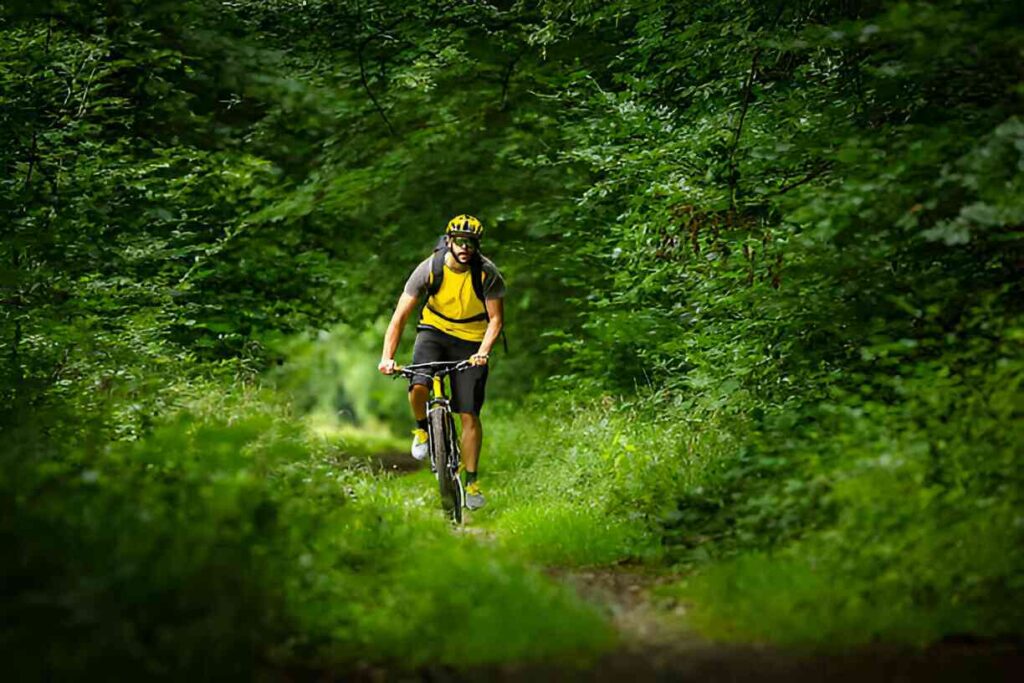
Pros vs. Cons of Mountain Biking Solo
When you know the major pros and cons of mountain biking solo, you would make a lot of decisions about your ride and take appropriate safety measures.
| Pros | Cons |
|---|---|
| Increased freedom and flexibility | Increased risk and responsibility |
| Opportunity for self-reflection and personal growth | Potential for loneliness and isolation |
| No need to compromise on route or pace | Limited ability to respond to emergencies |
| Improved mental toughness and confidence | Increased likelihood of getting lost or stranded |
| Enhanced connection with nature and surroundings | Difficulty in getting help in case of an accident |
Advantages: More Freedom and Flexibility
The greatest benefit when biking solo in the mountains is that you have full control of your riding schedule and pace—a chance to stop anywhere and rest as you please; you can take your time to appreciate the view around you without feeling pressed or hurried by others.
Disadvantages: Increased Risk and Responsibility
By the same token, solo mountain biking equates to more responsibility and more risk: Being more aware, carrying more gear, knowing how to handle an emergency.
It is important to be aware of possible risks so that one can be safe in solo mountain biking. Now, you have no friend to depend on, so you will be more self-dependent and prepared to encounter anything. This therefore means imperative tools and gear, knowing how to navigate, and being able to respond in case of emergencies. Knowing the risks involved and taking precautionary measures, one can minimize dangers involved and enjoy many of the benefits associated with solo mountain biking.
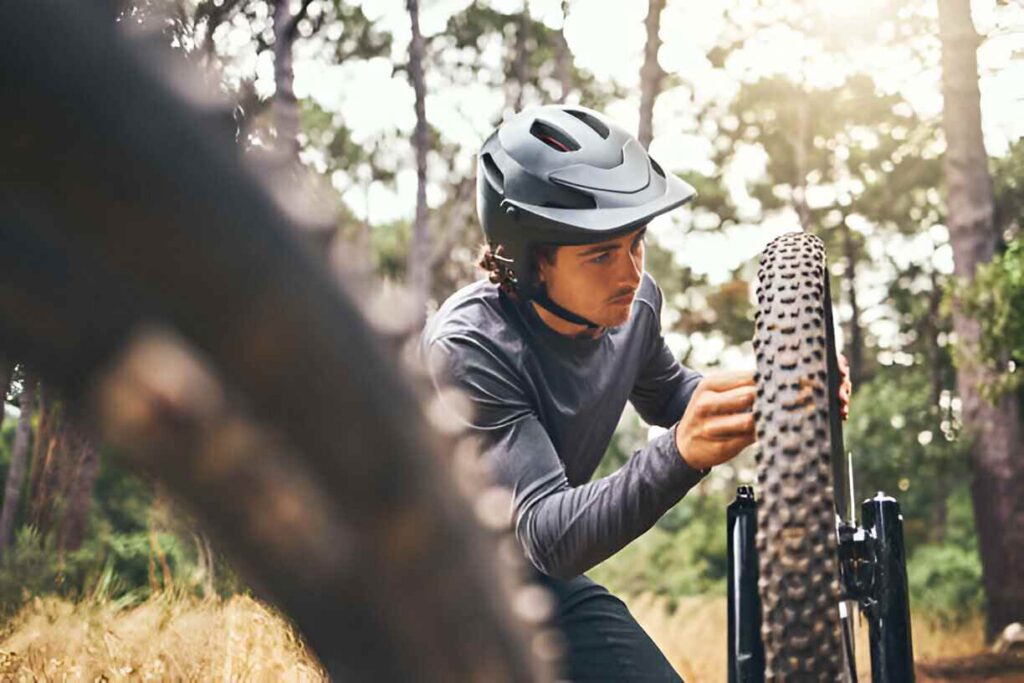
Real-Life Cases and Examples
Now, here are some cases of real-life mountain bikers who ride solo and have experienced successful rides and mishaps. It is through sharing these stories that one will understand the importance of abiding by safety tips and the necessity to be prepared for anything.
- In 2019, a 35-year-old solo mountain biker in Colorado became lost in the wilderness for 24 hours after he took a wrong turn. He had told no one about his route and didn’t have any devices, such as a GPS or satellite phone. Luckily, search and rescue teams found him alive and well.
- A solo mountain biker, 28, from remote California, broke her collarbone and had a concussion from a crash. She was lying there for hours, waiting to be rescued as there was no phone signal.
- In 2018, a 42-year-old solo mountain biker in Utah got stranded in the mountains for three days after his bike broke down—with no food or water—until he survived with only berries and stream water until he was saved by a helicopter team.
Successful Solo Rides and What Went Right
Went on a solo ride to the mountains and had a great experience? That is because you likely followed some important tips for safety. Here is what went right:
For example, a mountain biker from Oregon took proper precautions by planning the route, letting a friend know the route plan, and riding with a GPS device and first-aid kit. Nothing went wrong, and he enjoyed the nice view and peaceful atmosphere.
Mishaps and Near-Misses: What Went Wrong
Taken a solo ride and ended up having an accident or close call? Here is what went wrong:
For instance, when a mountain biker from Colorado solo rode into the backcountry and did not mention to anybody where he had been riding, neither carrying a GPS device nor a satellite phone with him, he got lost in the wilderness and spent the night outdoors before he was saved on the next day.
These may be caused by wrong decisions or a lack of preparation, consequently having accidents and near misses. This will enable the use of these examples to learn from other people’s mistakes, hence remaining safe and enjoying the solo ride.
Conclusion:
Having considered these 9 essential mountain biking safety tips for solo riders, the core of your ride’s safety and enjoyment appears to be about preparation and that little extra. In short, this means letting someone know where you’re going, packing all the vitals with you, planning out your route, and knowing your limits. With these tips, you’ll be all set for every eventuality the trail could possibly throw at you while you’re out riding solo. Stay safe, and happy trails!

